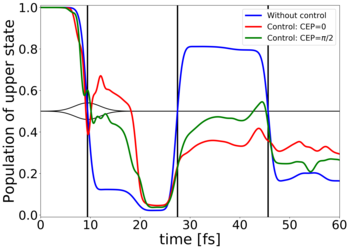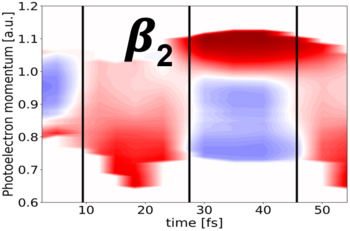1.1 Fundamentals of Extreme Photonics
Project coordinators: O. Smirnova , K. BuschT1: Attosecond dynamics (theory)
This topic focuses on the theory of attosecond response of matter to light in atoms, molecules, and condensed matter systems. The main research directions include
- Generation and characterization of UV, XUV and Xray light with tailored polarization properties;
- Attosecond spectroscopy in atoms, molecules, and solids;
Generation and characterization of light with tailored polarization properties
Interaction of intense laser fields with atomic or molecular gases generates very high harmonics of the incident field, up-converting the incident IR field into coherent, ultrashort bursts of XUV and soft Xray radiation. We study how one can control the polarization properties of the generated XUV light by tailoring the polarization properties of the incident field.
This work involves both microscopic and macroscopic components of nonlinear light propagation in dense gases.
Generation of attosecond pulses must come together with their characterization. We develop methods for complete characterization of generated attosecond pulses, including pulses with complex time-dependent polarization.
Characterization of attosecond pulses with complex, time-dependent polarization. Left panel: schematic of the setup, which uses a pair of time-locked pulses: the attosecond pulse and a linearly polarized infrared pulse. Right panel: Angle-resolved spectra recorded as a function of the delay between the asec and IR pulses allow one to fully reconstruct the asec pulse, including degree of depolarization (here 1-0.85=0.15).
Attosecond spectroscopy in atoms and molecules
Non-equilibrium dynamics of electrons in atoms and molecules develops on the attosecond time scale. These dynamics can be resolved using isolated attosecond pulses or pulse trains, or the combination of an attosecond pulse locked to the oscillations of the infrared field.
We develop theoretical description of the application of these tools to track electronic motion in atoms and molecules with attosecond temporal resolution, including resolution of photoionization in time and space and imaging spin-orbit dynamics.
Ultrafast transition through the conical intersection in NO2. Left panel shows population of the upper adiabatic state, vertical lines show when the vibronic wavepacket passes through the conical intersection (CI). Right panel shows how analysis of angle-resolved photo-electron spectra produced by ionization with 1 fsec XUV pulse, specifically the β2 parameter in the expansion of the spectrum in Legendre polynomials, faithfully reproduces the motion through the CI.
An important topic is coupled electronic and nuclear dynamics in molecules, triggered by ultrafast coherent electronic excitation. Here, we develop ways of imaging and controlling these dynamics using precisely tailored few-cycle infrared and sub-femtosecond XUV pulses.
An interesting route to attosecond spectroscopy is based on using intense infrared laser fields to rip a valence electron from an atom or a molecule, accelerate it with the laser electric field, and then scatter it off the parent atom or molecule, all within a single laser oscillation. This process leads to attosecond laser-induced electron diffraction and electron holography, which combines attosecond temporal resolution, thanks to laser-controlled electron dynamics, with angstrom spatial resolution, thanks to the short de Broglie wavelength of the returning electron.
Attosecond spectroscopy in solids
Attosecond or few-femtosecond electron and spin dynamics in solids is an important direction, with the dream of controlling charge and spin dynamics at peta-Hertz rates, by using electric fields where individual oscillations are tailored to trigger the desired response. Our current work focuses on using high harmonic generation to time-resolve ultrafast electronic response in strongly correlated and topological materials, for example mapping out phase transition between trivial and topological phases.
High harmonic spectroscopy of the insulator to metal phase transition in Fermi-Hubbard model. Left panel shows, for each ratio of on-site repulsion U to the hopping parameter t0, how the external field increases the relative number of doublon-hole pairs during the pulse. Right panel shows that high frequency emission is limited to the temporal window during which the phase transition takes place.





